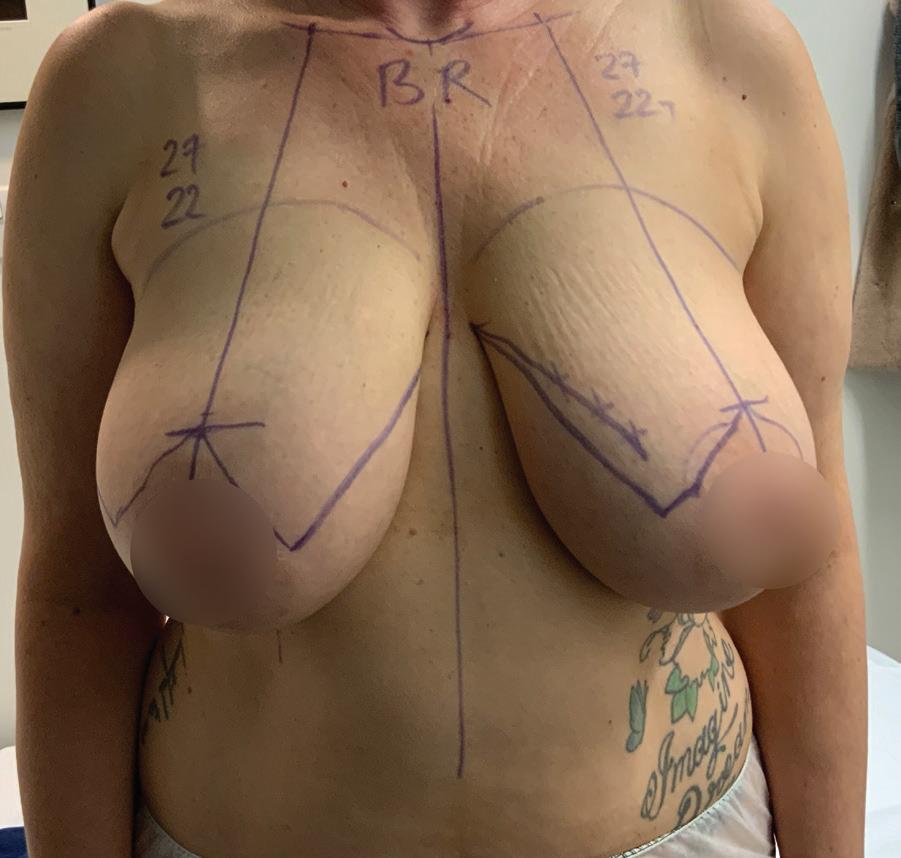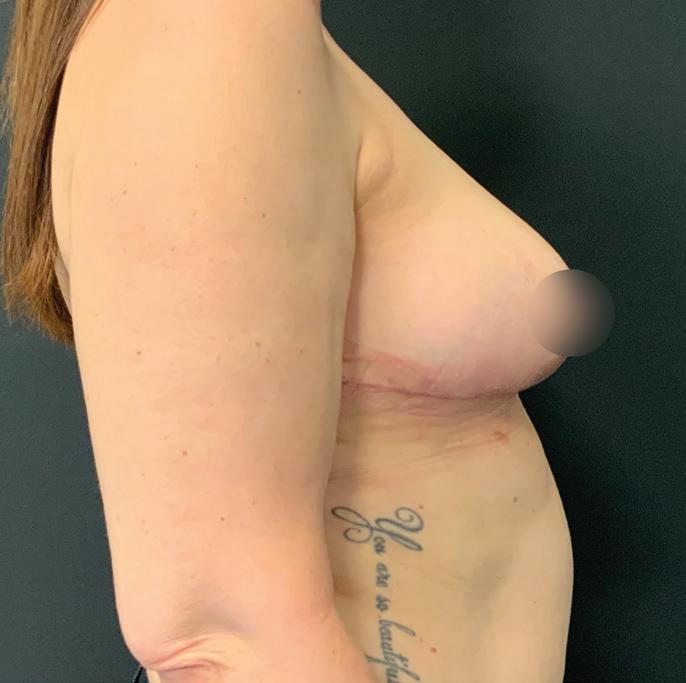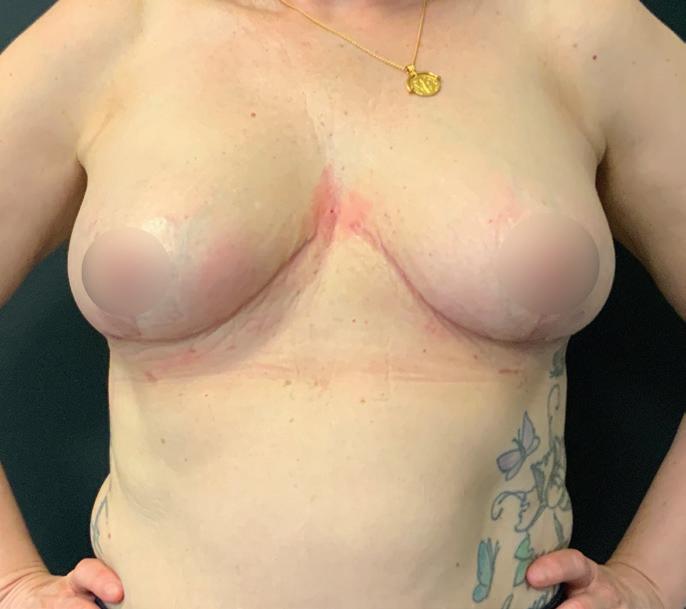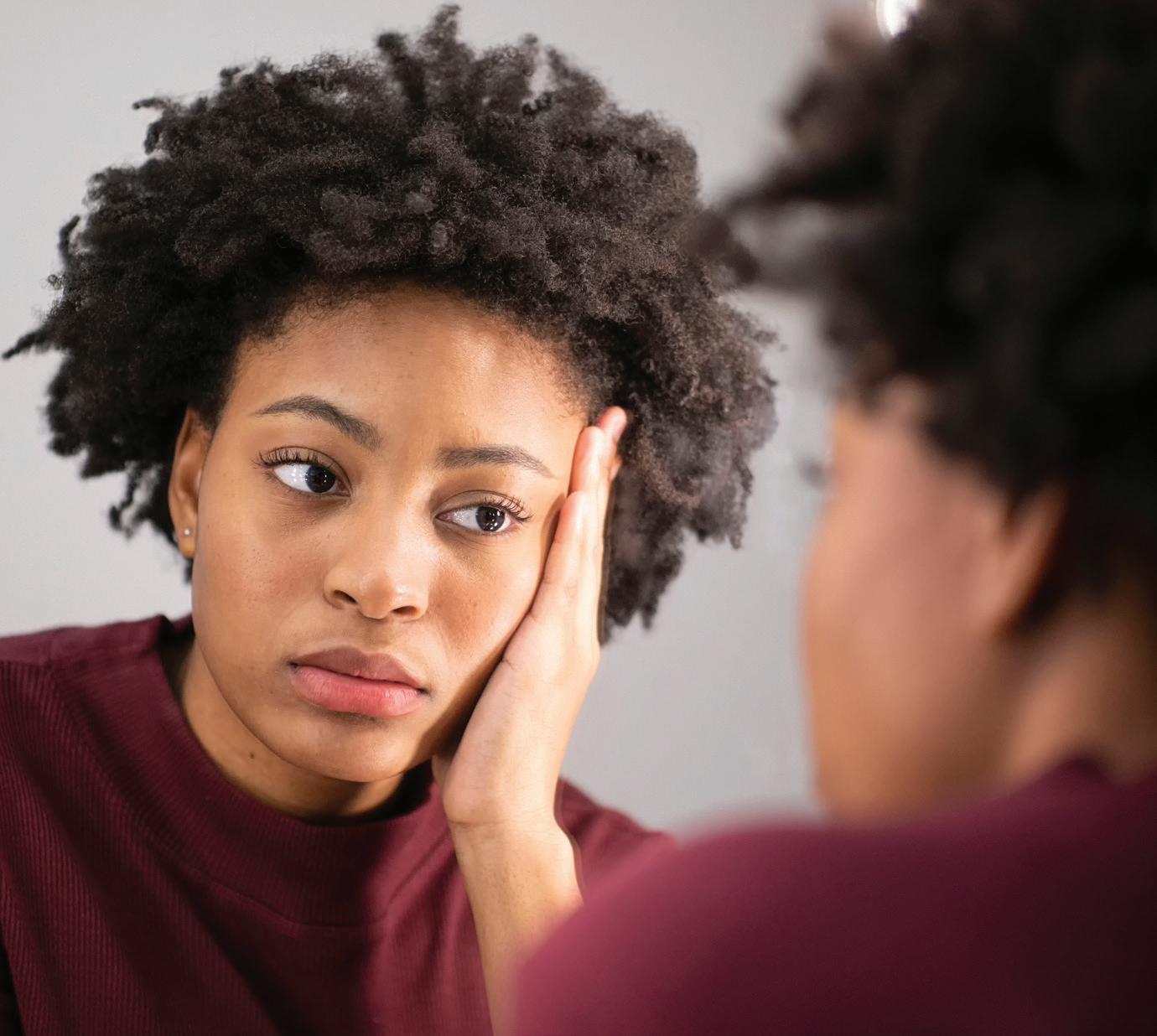
11 minute read
How radiofrequency can address your concerns around the eyes Boost Your Collagen in 30 Minutes! A two-in-one treatment to tackle skin sagging and more
Boost Your Collagen in 30 Minutes!
The sought-after collagen stimulating treatment that uses two effective technologies in one
Advertisement
Did you know that from your 20s your body produces 1-2% less collagen every year? It’s also worse for women, who will shockingly lose 30% of their collagen in the first five years of the menopause! As collagen is the scaffolding that holds our skin in place, losing it is one of the big reasons we begin to look older and start to display fine lines and wrinkles across the face and body. These may seem like disappointing facts, but the good news is, for those who would like to improve their signs of ageing, companies are continuously developing new technology like radiofrequency microneedling. This treatment can help not just ageing, but a whole range of skin concerns like acne, scars, loose skin and more!
HOW DOES RADIOFREQUENCY MICRONEEDLING STIMULATE COLLAGEN?
Radiofrequency microneedling is a treatment that combines two well-known and successful rejuvenation technologies into one system – bringing you the remarkable benefits of both. Microneedling is sometimes referred to as ‘collagen induction therapy’ and involves pricking the skin with tiny, sterilised needles to create microchannels and essentially cause an injury to the area. The skin responds to the presence of these tiny micro ‘wounds’ with an inflammatory reaction, stimulating the body’s natural healing powers, which results in increased collagen and elastin production and cell turnover – all good for a youthful look. This treatment can achieve exceptional results, but to go one step further radiofrequency energy (a fluctuating electrical current) is added. This utilises the physical action of microneedling and also carefully delivers heat energy to target different depths of the skin. The heat or ‘thermal stimulation’ creates a rejuvenation and tightening effect to the skin’s appearance, softening lines and wrinkles, and allowing the skin to become more resilient.
HOW CAN IT BENEFIT YOU?
This two-in-one treatment will kickstart your body into regenerating and healing itself, producing natural and rejuvenating results. Radiofrequency microneedling is a popular intervention to thicken the skin, reduce early signs of ageing, improve fine lines, wrinkles, enlarged pores, tighten the skin and reduce the appearance of blemishes and textural irregularities. It can also repair the skin and treat active acne, acne scars and stretch marks. The treatment can be used on all skin colours and is particularly good for treating acne scarring on darker skin types, which can be difficult to treat with other devices such as lasers. It is a non-surgical and minimally-invasive procedure, meaning that it does not have the risks associated with cosmetic surgery. Potential side effects that could occur include temporary redness, tingling, and a burning sensation while
LOVED BY PRACTITIONERS
“The combination of radiofrequency and microneedling is an exceptional treatment for many patients, offering fast and effective rejuvenation options without undergoing more invasive treatment like surgery. If choosing to embark on this kind of treatment, see a practitioner who uses a reputable device such as the Potenza by Cynosure to help you reach your cosmetic goals and achieve outstanding results.” Aesthetic practitioner Dr Benji Dhillon, Define Clinic Beaconsfield, IG: @defineclinic Patients can expect to pay from £500 for one treatment, depending on the clinic. Individual results may vary and are not guaranteed.
receiving treatment. A qualified practitioner will be able to inform you of the risks involved, pre-and postoperative care, and any other relevant information. The procedure only takes 25-35 minutes, depending on the treatment area, and because the technology is encouraging your own body to create collagen, your skin will improve over the following months. Results will usually be seen after 12 weeks.
CHOOSING A PROVIDER
There are many different devices available, so it’s important to choose a practitioner who uses the best technology that’s backed by science. The newest device that’s just launching in Europe is the Potenza. Created by one of the industry leaders in energy-based aesthetic technology, Cynosure, this radiofrequency microneedling technology can help a whole range of skin and body cosmetic and dermatologic concerns and can even be used to improve active acne. To find your nearest Potenza provider, search Cynosure UK online.
Before After
Before and after three treatments of the Potenza microneedling radiofrequency device. Patient treated by Dr D.J. Yoon.
To find your nearest Potenza provider scan the QR code.
This advertorial was reviewed and funded by Cynosure
LIFE CHANGING SURGERY
How breast reduction has had a positive impact on one woman’s day-to-day life
Thousands of women every year choose to reduce the size of their breasts. Although for many the decision is related to cosmetic improvement, for others like 53-year-old Pamela, it's about more than the aesthetic. As she tells it, breast reduction can be a life-changing procedure, greatly impacting a woman’s quality of life.
Bursting the bubble of big busts
Ever since she was a teenager, Pamela has been big busted. After nursing two children, years of carrying the weight of 34GG breasts and going through the menopause, Pamela’s severe back pain and discomfort was getting too much. “My boobs were big and always in the way. After working on my feet all day as an aesthetician at my clinic Mortar & Milk, they were causing me so much back pain! The size often fluctuated; when I was pregnant and breast feeding, they were just gigantean – they were like melons! I would have done something about it earlier, but I was always a bit too scared for surgery.” The tipping point for Pamela was the menopause. “This took me over the edge because they just kept growing and growing. People don’t talk about this, but I was told at a breast exam that it’s common for breasts to change and increase during the menopause.” According to one study of 1,130 postmenopausal women, about one in five experienced an increase in breast size after menopause. Declining oestrogen levels caused by the menopause can also make breast tissue less elastic and they can become fattier, which may lead to sagging and shape changes. “My boobs were getting so big that I was in pain in the night and would have to readjust them to sleep! It would really impact my day-to-day life as well,” Pamela says, adding that she believes her breasts were impacting her ability to breath. “I suffer from asthma and, although I was on medication, I was having daily asthma attacks. After reading online that there are reports that breast reduction surgery can help improve breathing, I thought it might also be able to help improve my asthma,” she explains.
A careful consultation
After researching breast surgeons through conversations with friends and looking at reviews from websites such as RealSelf and Trustpilot, Pamela found consultant plastic, reconstructive and cosmetic surgeon Mr Naveen Cavale. “I contacted the Cadogan Clinic in London and when I met Mr Cavale, I knew straight away that he was the practitioner for me. I remember he was wearing tie dye Crocs with his name written on the toes and I just thought this man is good enough that he doesn’t need to look cool! He was also so reassuring and made me feel really comfortable, so that was it!” In the 45-minute consultation, Pamela outlined all of her concerns, including her asthma. “I spoke a lot about my asthma, and Mr Cavale was very careful to make it clear to me that he couldn’t promise that breast reduction was going to make it better but that it should help my back pain. I understood this and thought that alleviating my back pain was enough to have the procedure.” Mr Cavale explained the procedure and, importantly, the side effects in detail, before showing Pamela an animation to explain how it would work. He also went through Pamela’s medical history and, following this, said Pamela was a good candidate for breast reduction surgery.
The positive procedure
Several months later, Pamela arrived at the Cadogan Clinic for the surgery. She had already filled out a comprehensive questionnaire about her medical history and mental health, had a recent mammogram, and had a negative coronavirus test. She was given clear information about the surgery again and got changed into operating clothes – a gown, compression socks and special underwear. “The day was all a bit of a blur,” she recalls, “I remember the anaesthetist was very funny and kind, and explained the procedure in detail again. He asked me if I had any fears for the surgery, and I did say I was afraid of waking up while being operated on! He said it can happen, but it had never happened in one of his surgeries, which was very reassuring.” Pamela then spoke to Mr Cavale, who went through everything again and marked up her breasts, before she went into the operating theatre and got onto the bed. She chuckles, “He asked me what my favourite cocktail was, and I said I normally drink red wine, but I do like an old fashioned. Everyone joked saying old fashions are great and I don’t remember a single thing after that!” While Pamela was under general anaesthetic, Mr Cavale proceeded to create an incision and remove the required skin and breast tissue. If you think of the breast as being a pudding with a cherry on top, Mr Cavale took a slice of the pudding and folded it back together to create a smaller cake. It’s important Mr Cavale kept the cherry (the nipple) connected to the ‘plate’ to ensure it stayed in the middle and was kept alive by the blood supply. A total of 943g of tissue was removed, which is typical for a medium breast reduction, according to Mr Cavale, and Pamela was sewn up with dissolvable stitches.



The procedure took around three hours. “When I woke up, I was wearing a compression bra and in a bit of pain,” Pamela says, “I felt like I was burning, but it was manageable, and I was given some pain relief. I was taken to the recovery bay where I had lunch and the staff called my husband to reassure him everything had gone well. Four hours later he took me home.” Pamela was given a recovery pack that included aftercare instructions, antibiotics for five days, and pain relief medication, which she used for 36 hours and replaced with paracetamol for six days after that. It was recommended that she take two weeks off work, with limited exertion, sleep on her back and wear compression bras. “I ordered a bunch of MACOM compression bras, which the Cadogan Clinic recommended, and these were fantastic.” Pamela went back to the Cadogan Clinic after a week for a check-up, where her healing was assessed, and she was shown how to change her bandages. She returned six weeks later so Mr Cavale could assess the results.

Outstanding outcomes
Today, Pamela is wearing a 32C bralette, and struggles to find the words to describe how she feels after the procedure. “I am just ecstatic! I went from having pain in between my shoulders 24 hours a day to now only getting it towards the end of a long week of working. As I had hoped, my asthma is massively better; it’s certainly not cured, but I am just way less reactive.” Pamela is also happy from a cosmetic point of view. “The fact that my boobs are more in proportion to the rest of my body has really brought joy to my life. And I can wear a bralette which is just awesome! I’m never going back to a wired bra!” She adds that she has been using Exuviance Ultra Restorative Cream and Clinisept+ to help with healing and scar prevention. When asked if she has any regrets, Pamela says, “By the time I had my surgery I just wanted the boobs gone. I’ve never once thought that I shouldn’t do this; I was ecstatic from the moment I woke up.” She laughs that she has since shown her before and after pictures to many women and that she can’t recommend the treatment enough. “If anyone has concerns with the size of their boobs, then I always say don’t blink. It’s an expensive procedure, and I had to save for it, but it was totally worth it because it has completely changed my life!”
Before After
Before After
Before and after breast reduction surgery.
Mr Naveen Cavale,
consultant plastic, reconstructive and cosmetic surgeon, as well as UK national secretary for the International Society of Aesthetic Plastic Surgery, London IG: @realplastics
Practitioner perspective
As well as having no serious medical problems that would cause Pamela to be unsuitable for the procedure, she was a good candidate for breast reduction because she really understood the outcomes. Pamela was accepting of the scarring, as well as the risks, and I believed she was having the operation for the right reasons. This is not so much a cosmetic procedure, but one to help women with underlying issues such as back and shoulder pain and, because of this, most women are absolutely delighted with the results. It was crucial Pamela understood that although the procedure would improve her back problems, there was no guarantee it would improve her asthma. Asthma is made worse by exertion, so if you are overweight or carrying a lot of weight on your chest, your asthma can be worse. If you lose this weight it can get better as you are needing to exert less, so it makes sense that Pamela saw some improvement, which was a great outcome for her. Patients need to be aware that these days, it’s really difficult to get a breast reduction on the NHS. I expect that due to the pandemic it’s unfortunately going to become virtually impossible and will be pushed right to the back of the queue. In private practice, patients can expect to pay around the £7-8,000 for a breast reduction procedure.










